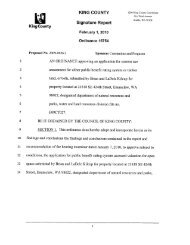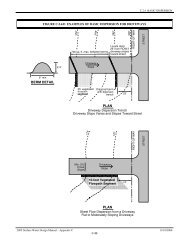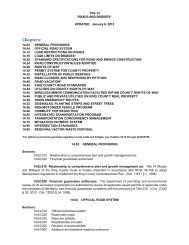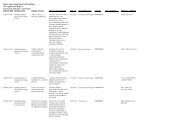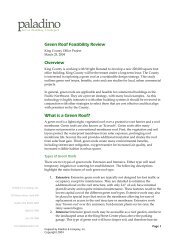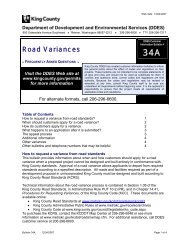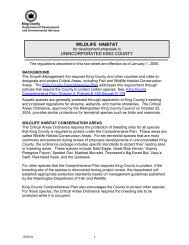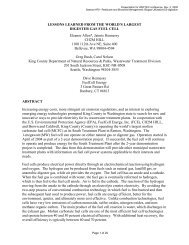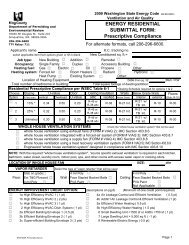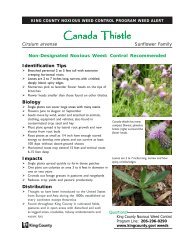Title 16 - BUILDING AND CONSTRUCTION ... - King County
Title 16 - BUILDING AND CONSTRUCTION ... - King County
Title 16 - BUILDING AND CONSTRUCTION ... - King County
Create successful ePaper yourself
Turn your PDF publications into a flip-book with our unique Google optimized e-Paper software.
1. A slope of cut and fill surfaces shall not be steeper than is safe for both the intended use and<br />
soil type and shall not exceed two horizontal to one vertical;<br />
2. All disturbed areas including faces of cuts and fill slopes shall be prepared and maintained to<br />
control erosion in compliance with K.C.C. <strong>16</strong>.82.095;<br />
3. The ground surface shall be prepared to receive fill by removing unsuitable material such as<br />
concrete slabs, tree stumps, brush, car bodies and other materials as determined by the department;<br />
4. Except in an approved sanitary landfill or as part of engineered fill, fill material shall meet the<br />
following standards:<br />
a. Fill material shall consist of earthen material, organic material or recycled or reprocessed<br />
materials that are not categorized as dangerous waste under <strong>Title</strong> 173 WAC and that were produced<br />
originally from an earthen or organic material;<br />
b. Fill material shall have a maximum dimension of less than twelve inches;<br />
c. Recycled concrete shall be free of rebar and other materials that may pose a safety or<br />
health hazard;<br />
d. Recycled asphalt shall not be used in areas subject to exposure to seasonal or continual<br />
perched ground water, in a critical aquifer recharge area or over a sole-source aquifer; and<br />
e. Recycled materials that have not been reprocessed to meet the definition of common<br />
borrow shall be intermixed with well-graded, natural, earthen materials in sufficient quantities and of a<br />
suitable size to assure filling of all voids and to assure that the fill can be compacted to ninety percent of<br />
the maximum density;<br />
5. Provisions shall be made to:<br />
a. prevent any surface water or seepage from damaging the cut face of any excavation or the<br />
sloping face of a fill; and<br />
b. address any surface water that is or might be concentrated as a result of a fill or excavation<br />
to a natural watercourse in accordance with K.C.C. chapter 9.04 and the Surface Water Design Manual;<br />
6. Benches and any swales or ditches on benches shall be designed in accordance with the<br />
<strong>King</strong> <strong>County</strong> Surface Water Design Manual;<br />
7. The tops and the toes of cut and fill slopes shall be set back from property boundaries and<br />
structures as far as necessary:<br />
a. for the safety of the adjacent properties;<br />
b. for adequacy of foundation support;<br />
c. to prevent damage resulting from water runoff or erosion of the slopes; and<br />
d. to preserve the permitted uses on the adjacent properties; and<br />
8. All fill shall meet the following:<br />
a. Fill greater than three feet in depth shall be engineered and compacted to accommodate the<br />
proposed use unless a notice on title documenting the location of the fill is recorded and the fill is<br />
sufficiently stable to not pose a hazard; and<br />
b. Any fill in the floodplain shall, from the face of the fill to a horizontal distance of six feet back<br />
from the face, meet the compaction requirements for pond embankments in the Surface Water Design<br />
Manual, unless determined by the department that inundation is not a threat to fill integrity or that other<br />
requirements necessary for compliance with the <strong>King</strong> <strong>County</strong> Guidelines for Bank Stabilization (Surface<br />
Water Management 1993) are met.<br />
B. Access roads to grading sites shall be:<br />
1. Maintained and located to the satisfaction of the <strong>King</strong> <strong>County</strong> department of transportation to<br />
minimize problems of dust, mud and traffic circulation;<br />
2. Located where the permanent access to the site is proposed in the permit application to<br />
minimize site disturbance; and<br />
3. Controlled by a gate when required by the department.<br />
C. Signs warning of hazardous conditions, if determined by the department to exist on a particular<br />
site, shall be affixed at locations as required by the department.<br />
D. Where required by the department, to protect life, limb and property, fencing shall be installed<br />
with lockable gates that must be closed and locked when not working on the site. The fence shall be no<br />
less than six feet in height and the fence material shall have no opening larger than two inches.<br />
E. Rocks, dirt, mud, vegetation and any other materials used or produced on-site in the course of<br />
permitted activities shall not be spilled onto or otherwise left on public roadways or any off-site property not<br />
specifically authorized as a receiving site under a valid permit.<br />
F. The duff layer and native topsoil shall be retained in an undisturbed state to the maximum<br />
extent practicable. Any duff layer or topsoil removed during grading shall be stockpiled on-site in a<br />
designated, controlled area not adjacent to public resources and critical areas. The material shall be<br />
reapplied to other portions of the site where feasible.<br />
G.1. Except as otherwise provided in subsection G.2. of this section, areas that have been<br />
cleared and graded shall have the soil moisture holding capacity restored to that of the original<br />
undisturbed soil native to the site to the maximum extent practicable. The soil in any area that has been



